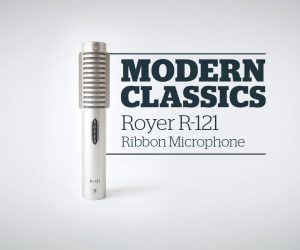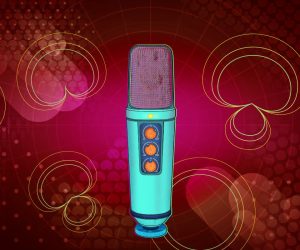
Royer Labs dBooster
Royer Labs introduces their entry to the in-line microphone booster market. Jonathan Burnside likes what he hears and talks to Royer’s Rick Perrotta about how it works.
Recording an album for the Melvins some decades ago, I put an RCA 74B a few feet back from King Buzzo’s Sunn amp and had my first listen to a ribbon mic. A friend had gifted it as a joke; he’d grabbed it at a garage sale, found it to be noisy and dismissed it as an unusable relic from a bygone day. As usual, I had an SM57 crammed up on one of Buzzo’s 12-inch speakers. When I listened to the RCA ribbon, it didn’t have the ugly 6kHz sizzle inherent to SM57s. The signal was indeed noisy, but noise was never an issue on Melvins’ albums so I rolled tape and never looked back.
I quickly learned that dynamic and condenser mics have a high resonant frequency that results in a perceived boost in the high mids (a bump I don’t want on fuzzy guitars) while ribbon mics have a low resonant frequency that is not an issue with electric guitars and is easily compensated for with a high pass filter. I soon bought other vintage ribbons – RCAs, Coles and Beyers – and started using them for drum overheads as well as guitars because they didn’t exacerbate the pronounced high-mid frequencies of a punk drummer smashing half-opened high hats. I found, however, that I had to be selective about the preamps I used with them. New manufacturers like Royer, AEA and Cascade helped ribbon mics become a studio mainstay, but their low output level and need for high impedance inputs made them problematic for using with prosumer preamps and with vintage preamps that had low impedance inputs. I opted to use modern preamps from Grace, Millennia and AEA to solve these problems, but always wished I could run my ribbon mics through any preamp in my studio to take advantage of their characteristic tones.
BOOSTERS
A few years back I heard about in-line mic level boosters like the Cloudlifter, the FetHead and others. My ears pricked up and I read favourable reviews, but the reviewers were using prosumer preamps where the added gain from an in-line booster would almost certainly deliver better results than running the preamp flat out. Also, those reviews didn’t address my concern about whether the sound of my ribbons would be subtly degenerated; my fear was that the in-line booster would help the prosumer preamp perform more impressively due to better impedance matching and less gain requirement, but the booster itself would alter the optimal sound of the microphone. So I sat the booster craze out – until I heard that Royer, the designers of modern-classic ribbon mics, had introduced the dBooster. Royer was the first manufacturer to introduce active ribbon microphones to overcome the need for mic preamps with high input impedances, low noise and high gain, so I was curious to see what they’d come up with in a booster.
dBOOSTER
The dBooster is about half the size of a typical DI box with an XLR input, an XLR output and a press button switch offering +12dB or +20dB of gain. As with all boosters it provides a high impedance input for the microphone, and internal gain to get the signal level up. As with most other boosters, it blocks phantom power from damaging your precious vintage ribbon mics.
The benefits of a booster for passive ribbon mics and dynamic mics are obvious, and I didn’t see any point in making a ‘booster versus no booster’ comparison. I was more interested in the way that different boosters affected the sound of my ribbon microphones. So I decided to compare the dBooster against the popular Cloudlifter CL-1. With the dBooster offering up to 20dB of gain and the Cloudlifter CL-1 offering up to 25dB of gain, both would allow me to stay within the sweet spot of my chosen preamp’s gain structure.
NEED TO KNOW
Royer Labs dBooster
Inline Mic Gain Booster

IN USE
I recorded several guitars into Pro Tools via a DI box, and used a Reamp box to play them back from Pro Tools into my 1993 Fender Vibro-King guitar amp. The recording path for the comparisons was an AEA R92 ribbon mic on the amp, through the booster being tested and into the Spectra Sonics V610 (see my review in AT issue 133). I level compensated the V610 for the discrepancies between the different boosters’ output levels. With this method I was able to record the same performance repeatedly with the only significant variable being the booster that was in line on each Reamped track.
Using Nugen Audio’s ‘MasterCheck’ plugin I compensated for the remaining small level differences between the tracks and did blind testing. (As well as making AB blind testing possible, MasterCheck gives a level-compensated insight into the processing you’re applying and also shows exactly where the loudness of your track is living.) It was easy to hear the difference between the two boosters, and I chose the dBooster in every randomised test. It provided more weight and punch in the low mids, and less of a ‘cheap condenser mic’ sound in the high mids. It sounded like an AEA R92 running into a well-matched preamp. In comparison, the Cloudlifter CL-1 tracks sounded slightly processed with a bit more sizzle on top and less punch. The difference was easily and consistently recognisable.
I also tested the dBooster with a variety of dynamic and ribbon mics going into the various preamps in my studio, and quickly saw the advantages. It turned Shure SM57s and SM7s into viable vocal mics, with their 6kHz bump seemingly not so forward while also sounding chewier and flatter in frequency response.
I also found that I got more control over the compression that followed the preamp because the dBooster’s added gain allowed me to run the preamp in its sweet spot – where it sounded best – while also providing enough output level to drive the compressor that followed it. I could set the threshold much higher to grab just the peaks, or I could pull it down and slam it harder if desired. This was a great problem solver for my Spectra Sonics V610s; my only problem using ribbon mics with the V610s is that there’s not enough gain on their input to drive their fixed-threshold compressor/limiter into the gain reduction I might want. The dBooster solved this problem, allowing me to compress ribbons and dynamics as desired.
During this testing, I contemplated selling my AEA TRP (The Ribbon Preamp). The TRP has an input impedance of 18k ohms and offers up to 84dB of clean gain, so it was always a better choice for my ribbons than some of my vintage preamps with their input impedances as low as 300 ohms and only 65dB to 70dB of gain. Now that these gain and impedance problems are solved by the dBooster I’m able to choose preamps with more mojo for the recording at hand, rather than only the clean vanilla flavour of the TRP.
After hearing all this audio voodoo I decided to have a chat with Rick Perrotta, President of Royer, founder of Matchless Amplifiers and co-designer of the dBooster, to find out how they do it. See ‘Audio Voodoo’.

CONCLUSION
So there you have it, folks. With the dBooster I’m able to jam my dynamic and ribbon mics into any preamp, with my choice decided by the vibe of the track rather than the technical limitations of running low output mics into vintage preamps. Along with my coffee maker, it’s one of the best bang-for-buck appliances in my studio.
















RESPONSES